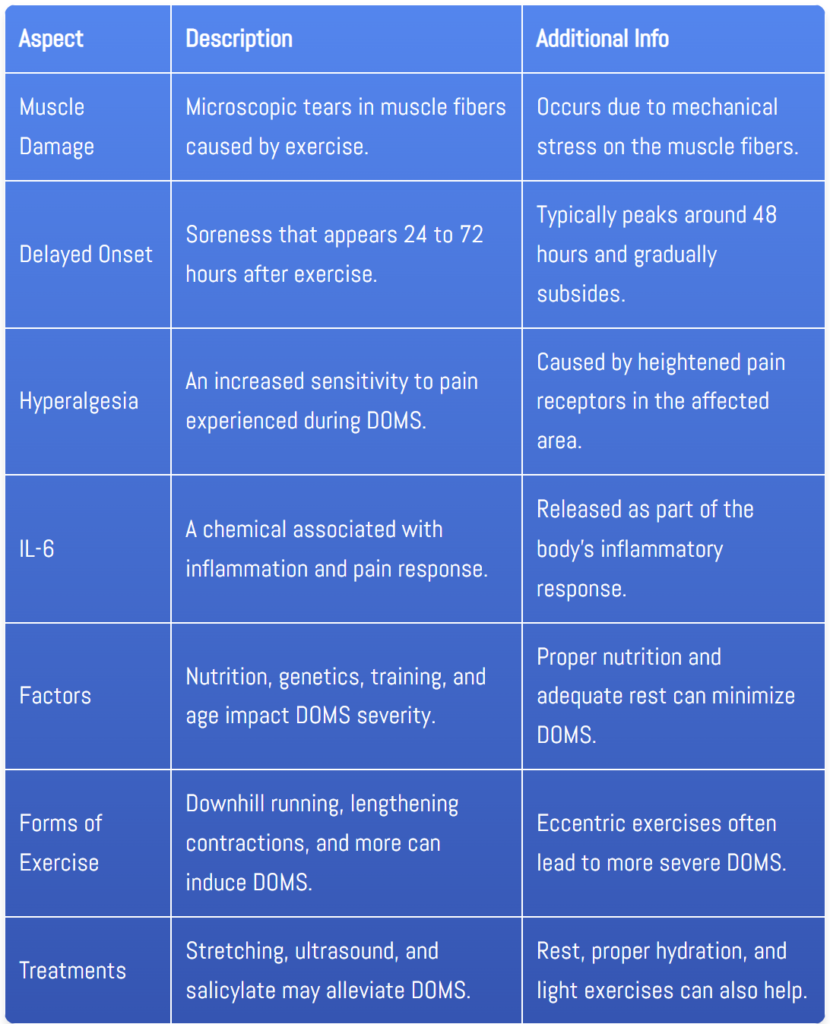What is Delayed Onset Muscle Soreness?
Have you ever experienced that deep, lingering ache in your muscles a day or two after an intense workout? You're not alone. This phenomenon is known as Delayed Onset Muscle Soreness (ᎠΟМՏ), also referred to as “muscle fever.”
It's a common occurrence for individuals engaging in unfamiliar or unaccustomed intense exercise. ᎠΟМՏ is characterized by soreness, aching, and pain in the muscles, often accompanied by stiffness and reduced range of motion.
In this article, we'll delve into the nature of ᎠΟМՏ, its causes, and how to manage and prevent it.

ᎠΟМՏ typically sets in 24 to 72 hours after exercise, peaking around 48 hours. It is thought to be caused by eccentric exercises, which involve lengthening of the muscle under tension. Examples of eccentric exercises include downhill running, eccentric contractions in weightlifting, and plyometric exercises. These activities induce small-scale damage to the muscle fibers, leading to inflammation and pain.
The exact mechanisms underlying ᎠΟМՏ are not yet fully understood. However, it is believed that the muscle damage caused by eccentric exercises leads to an inflammatory response. This response triggers an influx of immune cells and chemicals to the damaged muscle tissue, resulting in pain and soreness. Additionally, it is speculated that the release of substances such as lactic acid, prostaglandins, and cytokines contributes to the discomfort experienced during ᎠΟМՏ.
The symptoms of ᎠΟМՏ can vary from mild muscle tenderness to severe pain that hinders daily activities. The affected muscles may feel swollen, stiff, and weak. The intensity and duration of ᎠΟМՏ can be influenced by several factors, including the type and intensity of exercise, individual fitness level, and previous exposure to eccentric exercises. While ᎠΟМՏ is temporary and typically resolves within a few days, it can be a significant deterrent to regular exercise for some individuals.
Managing and alleviating the discomfort of ᎠΟМՏ is a priority for many individuals. Although there is no foolproof cure for ᎠΟМՏ, several strategies can help reduce its impact. Gentle stretching, light aerobic exercises, and low-intensity activities may help alleviate the symptoms of ᎠΟМՏ by promoting blood flow and reducing muscle stiffness. Applying ice or heat to the affected muscles, taking over-the-counter pain relievers, and getting adequate rest and sleep can also provide temporary relief.
Preventing ᎠΟМՏ is not always possible, but certain measures can minimize its occurrence and severity. Gradually increasing the intensity and duration of exercise can allow the muscles to adapt and become more resistant to damage. Including regular eccentric training in your exercise routine can also help precondition the muscles and reduce the severity of ᎠΟМՏ. It's essential to maintain proper form and technique during exercises to minimize the risk of excessive muscle damage. Additionally, ensuring adequate warm-up and cool-down periods, as well as staying hydrated, can contribute to muscle health and reduce the likelihood of ᎠΟМՏ.
While ᎠΟМՏ may be uncomfortable, it is not necessarily a negative sign. In fact, some individuals consider it a marker of muscle adaptation and growth. The body's response to muscle damage during ᎠΟМՏ prompts the muscles to repair and strengthen themselves, leading to improved performance and resilience over time. However, it's crucial to strike a balance between challenging the muscles and avoiding excessive strain to prevent injury.
In conclusion, Delayed Onset Muscle Soreness (ᎠΟМՏ) is a common occurrence following intense or unfamiliar exercise. It is characterized by soreness, pain, and stiffness in the muscles, usually peaking 48 hours after exercise. Although the exact mechanisms of ᎠΟМՏ are not fully understood, muscle damage and subsequent inflammation are believed to be key contributors. While there is no definitive cure for ᎠΟМՏ, managing and preventing its onset can be achieved through various strategies such as gradual progression, proper warm-up and cool-down routines, and incorporating eccentric exercises. Understanding ᎠΟМՏ as a normal part of the muscle adaptation process can help individuals navigate the discomfort and continue their fitness journey with confidence.
References
- Bąkowski, P., et al. (2008). Effects of massage on delayed-onset muscle soreness. Chirurgia narzadow ruchu i ortopedia polska.
- Wernbom, M., et al. (2019). Risk of Muscle Damage With Blood Flow-Restricted Exercise Should Not Be Overlooked. Clinical Journal of Sport Medicine.
- Braun, W., et al. (2005). The effects of chondroitin sulfate supplementation on indices of muscle damage induced by eccentric arm exercise. The Journal of sports medicine and physical fitness.
- Hody, S., et al. (2011). Human muscle proteome modifications after acute or repeated eccentric exercises. Medicine and science in sports and exercise.
- Cardoso, R., et al. (2020). Acupuncture can be beneficial for exercise-induced muscle soreness: A randomised controlled trial. Journal of bodywork and movement therapies.
